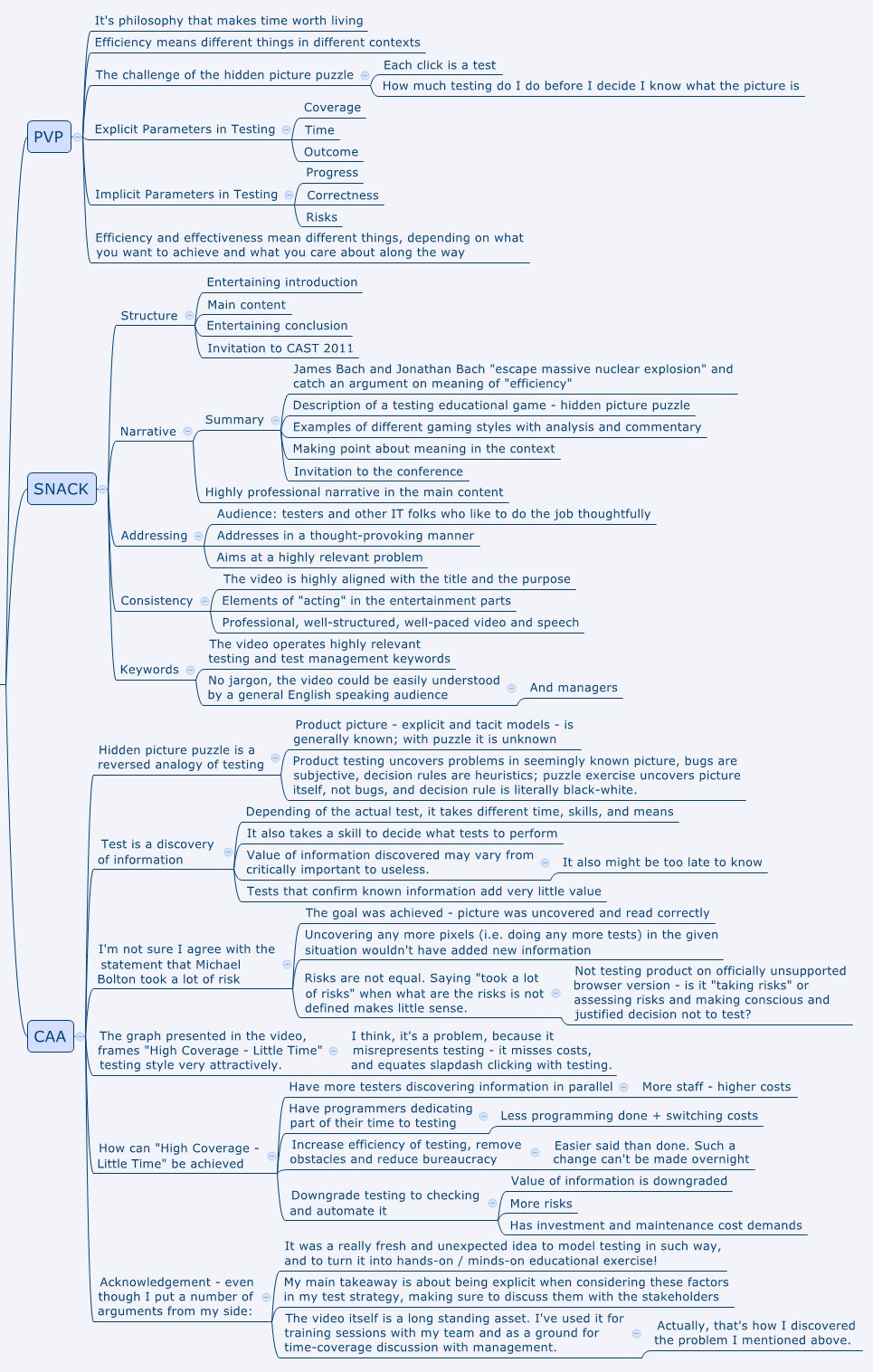Review: CAST 2011 Promo #2
Video
Mindmap
Review
Points – Value – Problems
- It’s philosophy that makes time worth living
- Efficiency means different things in different contexts
- The challenge of the hidden picture puzzle
- Each click is a test
- How much testing do I do before I decide I know what the picture is
- Explicit Parameters in Testing
- Coverage
- Time
- Outcome
- Implicit Parameters in Testing
- Progress
- Correctness
- Risks
- Efficiency and effectiveness mean different things, depending on what you want to achieve and what you care about along the way
SNACK
- Structure
- Entertaining introduction
- Main content
- Entertaining conclusion
- Invitation to CAST 2011
- Narrative
- Summary
- James Bach and Jonathan Bach “escape massive nuclear explosion” and catch an argument on meaning of “efficiency”
- Description of a testing educational game – hidden picture puzzle
- Examples of different gaming styles with analysis and commentary
- Making point about meaning in the context
- Invitation to the conference
- Highly professional narrative in the main content
- Summary
- Addressing
- Audience: testers and other IT folks who like to do the job thoughtfully
- Addresses in a thought-provoking manner
- Aims at a highly relevant problem
- Consistency
- The video is highly aligned with the title and the purpose
- Elements of “acting” in the entertainment parts
- Professional, well-structured, well-paced video and speech
- Keywords
- The video operates highly relevant testing and test management keywords
- No jargon, the video could be easily understood by a general English speaking audience
Comment – Argue – Acknowledge
- Hidden picture puzzle is a reversed analogy of testing
- Product picture – explicit and tacit models – is generally known; with puzzle it is unknown
- Product testing uncovers problems in seemingly known picture, bugs are subjective, decision rules are heuristics; puzzle exercise uncovers picture itself, not bugs, and decision rule is literally black-white.
- Test is a discovery of information
- Depending of the actual test, it takes different time, skills, and means
- It also takes a skill to decide what tests to perform
- Value of information discovered may vary from critically important to useless
- It also might be too late to know
- Tests that confirm known information add very little value
- I’m not sure I agree with the statement that Michael Bolton took a lot of risk
- The goal was achieved – picture was uncovered and read correctly
- Uncovering any more pixels (i.e. doing any more tests) in the given situation wouldn’t have added new information
- Risks are not equal. Saying “took a lot of risks” when what are the risks is not defined makes little sense
- Not testing product on officially unsupported browser version – is it “taking risks” or assessing risks and making conscious and justified decision not to test?
- The graph presented in the video, frames “High Coverage – Little Time” testing style very attractively
- I think, it’s a problem, because it misrepresents testing – it misses costs, and equates slapdash clicking with testing
- How can “High Coverage – Little Time” be achieved?
- Have more testers discovering information in parallel
- More staff – higher costs
- Have programmers dedicating part of their time to testing
- Less programming done + switching costs
- Increase efficiency of testing, remove obstacles and reduce bureaucracy
- Easier said than done. Such a change can’t happen overnight
- Downgrade testing to checking and automate it
- Value of information is downgraded
- More risks
- Has investment and maintenance cost demands
- Have more testers discovering information in parallel
- Acknowledgement – even though I put a number of arguments from my side:
- It was a really fresh and unexpected idea to model testing in such way, and to turn it into hands-on / minds-on educational exercise!
- My main takeaway is about being explicit when considering these factors in my test strategy, making sure to discuss them with the stakeholders
- The video itself is a long standing asset. I’ve used it for training sessions with my team and as a ground for time-coverage discussion with management.
- Actually, that’s how I discovered the problem I mentioned above.



